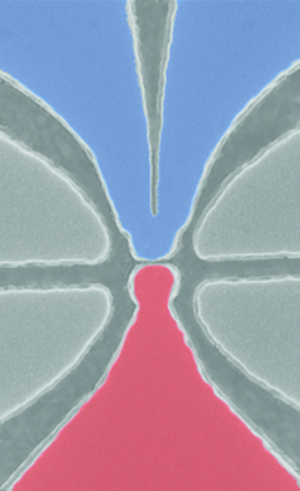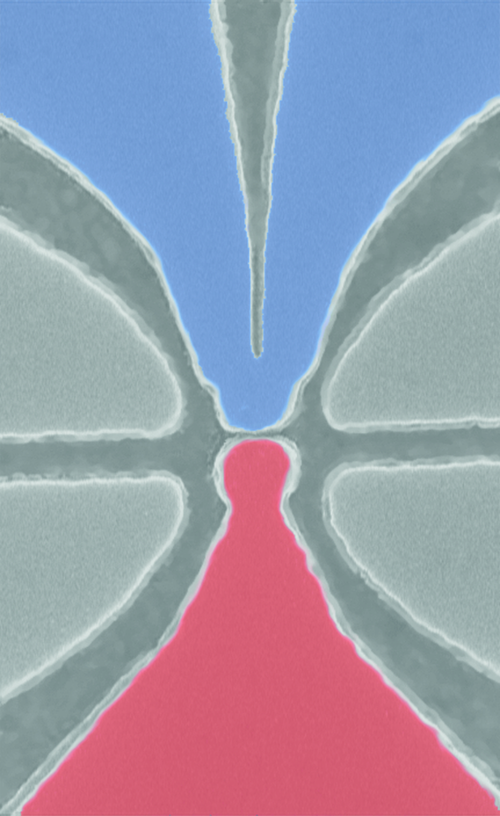Voltage Fluctuations Converted to Electricity
The waste heat generated in today’s electronic circuits limits efforts at miniaturization and at improving energy efficiency. Engineers hope to someday use that heat as an energy source, and now a team of physicists has demonstrated a step toward such energy harvesting. Their microscopic device extracts useful energy from tiny voltage fluctuations that mimic excess heat. They hope the results will lead to a general technology for nanoscale energy harvesting, which could provide the foundation for a new generation of ultra-efficient devices.
Waste heat creates temperature differences—hot and cold spots in a material—and researchers for several decades have been developing ways to get energy back from such differences. A wire placed across a temperature difference can generate an electric current if the wire is made of a so-called thermoelectric material. However, in such “two terminal” devices, the physical connection lets heat as well as electricity flow from hot to cold, thereby eroding the temperature difference.
Four years ago, Rafael Sánchez and Markus Büttiker of the University of Geneva proposed that energy might be harvested more effectively with a three terminal device [1]. Their design aimed to extract energy from a temperature difference while avoiding any direct connection from hot to cold along which heat might flow.
They envisioned placing a pair of quantum dots—tiny pieces of semiconducting material with easily tunable electrical properties—close together on a surface, with one at a slightly higher temperature than the other. The cooler dot would have two wires connected to it, providing a channel for current to flow. The warmer dot would act to influence the current flowing through the cooler one but without making any direct connection to it.
Thermal fluctuations in either dot drive electrons randomly into and out of it. But small voltages applied to the left and right sides of the cooler dot could make it preferable for electrons to enter from one side (say, the right) and exit at the other side. These voltages would be tuned to prevent an electron from escaping the dot unless it gets a boost of energy from the repulsion of an electron appearing on the nearby, warmer dot. This warmer dot would have stronger thermal fluctuations because of its higher temperature, and these would provide the energy needed to generate a net current through the cooler dot. As with the two-terminal designs, heat energy is used to generate current, but in this three-terminal design, much less energy is wasted simply heating up the cooler region.
A team led by Lukas Worschech of the University of Würzburg in Germany has now demonstrated this basic idea in a real device. They didn’t actually measure energy extraction from a temperature difference, because experiments cannot maintain and measure such differences accurately at the nanoscale dimensions of the device. Instead, they applied voltage fluctuations from a controlled voltage source to mimic the effects of a temperature difference and showed that the device works as envisioned.
The team engineered a semiconductor structure that allowed electrons to move freely in two dimensions, sandwiched between two layers, and fashioned a pair of quantum dots. By etching a trench of width 150 nanometers between the dots, they ensured that no electrons could flow between them; the dots could only influence one another through charge repulsion. With the conducting leads connected and the randomly fluctuating voltage applied to one dot, the team measured a current flowing across the second dot.
The new work “provides a significant advance towards energy harvesting at the nanoscale,” says Bjorn Sothmann of the University of Geneva. The next step, says Würzburg team member Fabian Hartmann, will be to test the device with an actual high temperature source rather than voltage fluctuations, but the team doesn’t foresee any special difficulties in doing so.
By maintaining temperature differences, Hartmann believes, this three terminal structure should become the basis for a high-efficiency energy harvesting device that would be especially useful for applications at the nanoscale. The design, the researchers say, is also flexible enough to allow energy to be extracted from other sources of random energy, including microwaves, if it were combined with suitable antennas.
This research is published in Physical Review Letters.
–Mark Buchanan
Mark Buchanan is a freelance science writer who splits his time between Abergavenny, UK, and Notre Dame de Courson, France.
References
- R. Sánchez and M. Büttiker “Optimal Energy Quanta to Current Conversion,” Phys. Rev. B 83, 085428 (2011)





